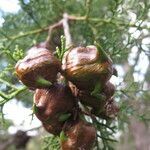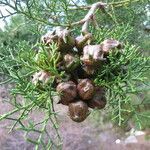Shrub or small tree up to 9 m high or, in the tropics, attaining a height of about 50 m, with stem diameter up to 2 m, crown pyramidal when young, spreading with age; bark on young trees reddish grey, thin, fibrous, flaking off annually. Leaves of two types; juvenile leaves on seedlings and young trees needle-like, spreading, 1-2 cm long and up to 2 mm broad; adult leaves scale-like, appressed, narrowly oblong, often not strictly decussate, subtriangular in transverse section, adnate at the base, free and adnate portions often equally long. Male cones mostly on short lateral branchlets; scales usually 6 pairs, decussate, coriaceous, peltate, broadly ovate with 4 pollen sacs at the base of each scale. Mature female cones consisting of usually 4 woody valves; valves smooth to wrinkled, not tubercled along margin, if warty then irregularly so. Seeds ovoid, conspicuously winged, somewhat flattened, outline including wings oblong-obovate, wing retuse at apex; seed scar about 1.5 x 2.5 mm. Cotyledonary leaves (after germination) 20-25 mm long and about 2 mm broad.
Shrub or small tree, up to 9 m high, crown pyramidal when young, spreading with age. Bark reddish grey, thin, flaking off annually. Leaves of two types with young ones needle-like, spreading, 10-20 x 2 mm, adult leaves scale-like, appressed, narrowly oblong. Cones: male cones small, 2-4 mm long, on short lateral branches, scales broadly ovate with 4 pollen sacs at base of each scale; female cones of 4 woody valves, valves smooth to wrinkled, maturing ± Mar., but cones of varying stages of development may be found throughout the year.
Monoecious tree, up to 9 m high, often less in EC; bark dark grey, flaking in strips. Leaves: juvenile leaves 10-20 x 2 mm, spreading; adult leaves scale-like, oblong, triangular in section. Male cones very small, usually of 6 pairs of broadly ovate scales. Female cones clustered, of 4 valves, outer margins warty, sometimes irregularly warty but not along margins. Fruit cones may take more than a year to ripen, and then persist for several years, may be found on trees all year.
Shrub or small tree, up to 9 m high. Valves of female cone smooth to wrinkled, not tubercled along margin, if warty then irregularly so; adult leaves on ultimate branchlets narrowly oblong, subtriangular in transverse section.
Monoecious shrub or tree to 10 m (to 50 m in tropics). Adult leaves scale-like, narrowly oblong, keeled, adpressed. Female cones with smooth to wrinkled valves.



